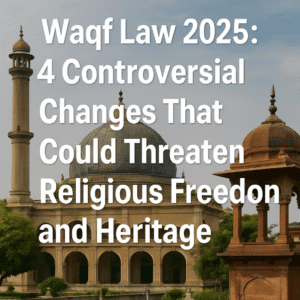Waqf Law 2025: 4 Controversial Changes That Could Threaten Religious Freedom and Heritage
India’s Waqf Act, 2025, has ignited controversy, with challenges filed in the Supreme Court over concerns of religious autonomy and property rights. Key issues include the abolition of “Waqf by use,” potentially stripping centuries-old Islamic sites of legal protection, and the inclusion of non-Muslims on Waqf boards, which critics argue violates Article 26 of the Constitution. The law also empowers district collectors to reclassify Waqf land, raising fears of bureaucratic overreach.
The removal of exemption from the Limitation Act further limits Waqf boards’ ability to reclaim encroached properties. Petitioners see these provisions as threats to Islamic heritage and self-governance, while the government frames them as measures to curb misuse. The Supreme Court’s upcoming ruling, expected after May 5, will be pivotal in defining the balance between state regulation and minority rights. Until then, temporary relief measures offer little certainty.
This legal battle marks a defining moment for India’s pluralistic principles in the face of expanding state control.

Waqf Law 2025: 4 Controversial Changes That Could Threaten Religious Freedom and Heritage
India’s newly enacted Waqf Act, 2025, has sparked intense debate, with a coalition of political leaders, religious figures, and parties challenging its constitutionality in the Supreme Court. At the heart of the dispute lie concerns over religious autonomy, property rights, and the balance between governance and community self-regulation. Here’s a breakdown of the critical issues driving the legal battle and their broader implications.
- The Erasure of ‘Waqf by Use’: A Threat to Historical Legacy
The Issue:
The 2025 law abolishes the concept of “Waqf by use” for future properties. Historically, this principle recognized land used for Islamic religious or charitable purposes (e.g., mosques, graveyards) as Waqf, even if unregistered, provided such use was longstanding.
Petitioners’ Argument:
Many Waqf properties, some centuries old, lack formal registration due to historical oversight or administrative gaps. Removing this provision jeopardizes their legal status, leaving them vulnerable to disputes or government claims. The Supreme Court itself acknowledged the practical difficulty of registering centuries-old sites, as noted during hearings.
Government’s Stance:
The Centre argues the change prevents fraudulent encroachment under the guise of Waqf. However, critics warn it risks erasing intangible heritage and disregards precedents like the 2019 Ayodhya judgment, which affirmed Waqf-by-use principles.
- Inclusion of Non-Muslims in Waqf Boards: A Question of Religious Autonomy
The Controversy:
The law permits non-Muslims to serve on Waqf boards and the Central Waqf Council, a departure from the 1995 Act.
Constitutional Clash:
Petitioners cite Article 26, which guarantees religious groups the right to manage their affairs. They argue that allowing outsiders into governance undermines a core tenet of Islamic jurisprudence, where Waqf is intrinsically tied to Muslim stewardship. As Senior Advocate Kapil Sibal emphasized, “Even one non-Muslim member is too many.”
Government’s Defense:
The Centre claims non-Muslim members won’t override the community’s veto on religious matters. Yet, the Supreme Court questioned the logic, asking if Hindus would accept Muslims on temple trust boards—a rhetorical point highlighting potential double standards.
- District Collectors’ Power: Preemptive Land Reclassification
The Provision:
District collectors can now reclassify Waqf-by-use land as government property pending court resolution. This shifts the burden of proof to Waqf boards, altering a property’s status before judicial review.
Risks and Reactions:
Critics fear this empowers local officials to unilaterally seize disputed properties, bypassing due process. While the Centre assured no immediate changes to Waqf statuses, the provision remains contentious. The Supreme Court hinted it might stay this clause, recognizing its potential for abuse.
- Limitation Act’s Applicability: A Race Against Time
The Change:
The 1995 Act exempted Waqf disputes from the Limitation Act, which sets deadlines for legal claims. The 2025 law removes this exemption, forcing Waqf boards to act within statutory timeframes to reclaim encroached properties.
Divergent Views:
The government frames this as curbing indefinite claims, but petitioners argue it weakens Waqf’s ability to protect assets, especially where encroachments go unnoticed for decades. The Supreme Court acknowledged the complexity, noting the Limitation Act’s “pros and cons.”
Broader Implications: Religious Rights vs. State Control
The case transcends legal technicalities, touching on deeper tensions between religious self-governance and state oversight. For Muslim communities, Waqf institutions symbolize not just property management but cultural preservation. Conversely, the government frames reforms as necessary to prevent misuse and ensure transparency.
Political undertones are evident, with petitioners spanning parties like AIMIM, TMC, and CPI, reflecting cross-ideological concern. The Supreme Court’s eventual ruling could set a precedent for how India navigates similar clashes in an era of increasing regulatory scrutiny over religious endowments.
What’s Next?
With the Supreme Court’s interim order delayed until May 5, all eyes are on whether the Bench will suspend contentious clauses. The outcome will hinge on balancing community rights with broader governance principles—a test of India’s commitment to pluralism in its evolving legal landscape.
For now, the assurance that non-Muslims won’t be appointed to boards and Waqf statuses remain unchanged offers temporary relief. But the final judgment will shape the future of Islamic heritage stewardship and redefine the boundaries of religious freedom in India.
You must be logged in to post a comment.